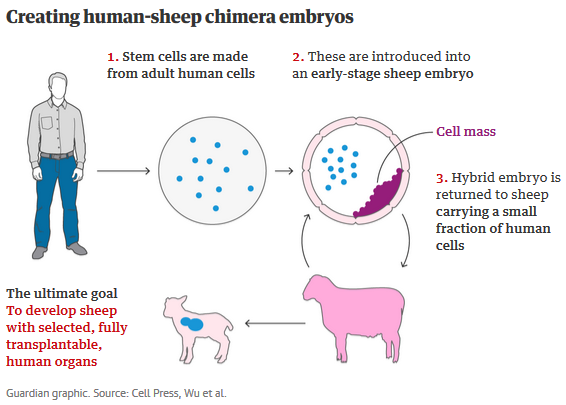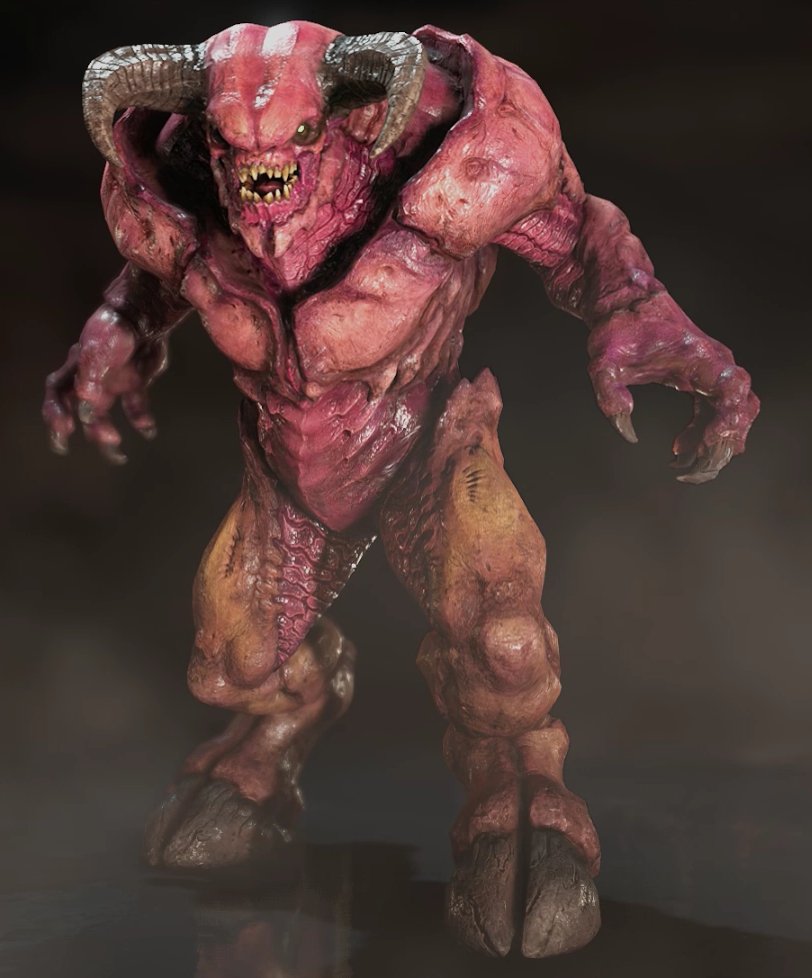It looks like you're using an Ad Blocker.
Please white-list or disable AboveTopSecret.com in your ad-blocking tool.
Thank you.
Some features of ATS will be disabled while you continue to use an ad-blocker.
6
share:
"Breakthrough as scientists grow sheep embryos containing human cells" - Chimeras
Now, at this week’s meeting of the American Association for the Advancement of Science in Austin, Texas, the team have announced that they have managed a similar feat with sheep embryos, achieving an even higher ratio of human to animal cells. “About one in 10,000 cells in these sheep embryos are human,” said Ross.

Screen cap from the source.
Most are aware of human stem cells introduced into pig embryos,
Attempts by scientists to grow organs from one species inside another is an ongoing mission: among previous efforts, scientists have grown a rat pancreas inside a mouse
But Ross and colleagues have recently reported a major breakthrough for our own species, revealing they were able to introduce human stem cells into early pig embryos, producing embryos for which about one in every 100,000 cells were human. These chimeras – a term adopted from Greek mythology – were only allowed to develop for 28 days.
Breakthrough as scientists grow sheep embryos containing human cells
Also that chimeras are nothing new, being created in a lab in the 60s, there has been rabbits, rats and cattle*.
The Cons(from the source):
“I have the same concerns,” said Ross, adding that the team are looking at where the human cells end up in the chimera. “Let’s say that if our results indicate that the human cells all go to the brain of the animal, then we may never carry this forward,” he said.
The researcher reply to that:
Nakauchi also played down concerns: “The contribution of human cells so far is very small. It’s nothing like a pig with a human face or human brain,” he said. “We have published several papers showing we can target the region, so we can avoid human cells differentiating in to the human brain or human gonads.”
Another issue is the blood vessels of the pancreas will not be human which could trigger the immune system into rejecting the organ. Viruses in the DNA of the host chimera animal that could infect the human cells.
However, recent developments in gene editing have allowed scientists to develop piglets without such viruses, potentially smoothing the way, while Ross notes that human cells might replace any remaining host cells after transplantation. Breakthrough as scientists grow sheep embryos containing human cells
Then, of course, there's the topic of humane treatment of the laboratory animals, to the topic of Chimeras being something humanity really shouldn't mess with. So far, as the source says, the Chimeric embryos are only allowed to develop for 28 days- 21 days for the sheep. However, that's not the same for all chimeras as seen with the monkeys reported last month-* more here.
Conclusion
I'd be the first one to step up and say I support organ transplants. Though, this new attempt with a cure for Diabetes Type I and more, really needs to be researched more thoroughly. More so I don't see what's wrong with taking the following path of researching more into the growing the organs outside of a host body instead, as it will stop the potential issues above.
Scientists Grow Full-Sized, Beating Human Hearts From Stem Cells
Ideally, scientists would be able to grow working hearts from patients’ own tissues, but they’re not quite there yet. That’s because organs have a particular architecture. It's easier to grow them in the lab if they have a scaffolding on which the cells can build, like building a house with the frame already constructed.
Source - Popsci
A whole sheep can be "grown", why not organs in a similar manner?
Source- TheVerge
An artificial womb successfully grew baby sheep — and humans could be next
Inside what look like oversized ziplock bags strewn with tubes of blood and fluid, eight fetal lambs continued to develop — much like they would have inside their mothers. Over four weeks, their lungs and brains grew, they sprouted wool, opened their eyes, wriggled around, and learned to swallow, according to a new study that takes the first step toward an artificial womb. One day, this device could help to bring premature human babies to term outside the uterus — but right now, it has only been tested on sheep.
originally posted by: skunkape23
Sheeple are a real thing now.
Not just a metaphor.
Exactly.
Truth is American scientists achieved this decades ago and have been using these creatures to breed with normal humans. A massive part of the population are now hybrids.
That is why the US is in the current state it is in.
originally posted by: Nexttimemaybe
originally posted by: skunkape23
Sheeple are a real thing now.
Not just a metaphor.
Exactly.
Truth is American scientists achieved this decades ago and have been using these creatures to breed with normal humans. A massive part of the population are now hybrids.
That is why the US is in the current state it is in.
I am aware of the mass mind-control via media thing.
Is there any proof that any humans are actually "hybrids" that you can provide.
I don't doubt that it is possible.
Hell, I may be one myself.
DNA scans for everyone?
I know the Russians tried human/ape hybrids before I was born.
Who knows what escaped from the laboratories.
a reply to: skunkape23
Going around the place where I live, there are definitely hybrids alright, I’m not sure what there are, but there not entirely human put it that way...
Going around the place where I live, there are definitely hybrids alright, I’m not sure what there are, but there not entirely human put it that way...
a reply to: dreamingawake
I noticed in the diagram there it says
“The ultimate goal to develop sheep with selected, fully transplantable, human organs”
Wouldn’t it be easier to develop humans with sheep brains?
Oh wait a minute...
However I suspect the ultimate goal is actually to achieve immortality for our sociopathic overlords.
I noticed in the diagram there it says
“The ultimate goal to develop sheep with selected, fully transplantable, human organs”
Wouldn’t it be easier to develop humans with sheep brains?
Oh wait a minute...
However I suspect the ultimate goal is actually to achieve immortality for our sociopathic overlords.
a reply to: dreamingawake
Sure....
Doctor Moreau, hows everything going on Genetic Isle?
These chimeras – a term adopted from Greek mythology – were only allowed to develop for 28 days.
Sure....
Doctor Moreau, hows everything going on Genetic Isle?
edit on 18-2-2018 by intrptr because: bb code
After moving to the country as a teen, I heard all kinds of stories of guys with farm animals. Don't think that resulted in hybrid beings. But
again, some unusual looking creatures out here which is why I moved to the city.
This can only end badly. Will humans stop at nothing for an extra few years of life?
And this is good? Why would this be good? Most people are already sheep, I think that sucks.
edit on 18-2-2018 by rickymouse because: (no
reason given)
a reply to: skunkape23
Oliver, the said Humanzee, was said to have tested non human. Could be a reference to that lab that contained him.
Oh yeah, forgot that and Stalin's Humanzees and the Almas-Mongolian for "wild man", should have added a history part, though figure it's mostly debunked... or is it.
Joseph Stalin's Humanzee Experiments [FULL DOCUMENTARY]
Shares the title subject and more.
The Humanzee Experiments
Here's another attempt or so it has been claimed:
Oliver, the said Humanzee, was said to have tested non human. Could be a reference to that lab that contained him.
Oh yeah, forgot that and Stalin's Humanzees and the Almas-Mongolian for "wild man", should have added a history part, though figure it's mostly debunked... or is it.
Joseph Stalin's Humanzee Experiments [FULL DOCUMENTARY]
Shares the title subject and more.
The Humanzee Experiments
Here's another attempt or so it has been claimed:
wiki
In the 1980s, there were reports on an experiment in human–chimpanzee crossbreeding conducted in the People's Republic of China in 1967, and on the planned resumption of such experiments. In 1981, Ji Yongxiang, head of a hospital in Shengyang, was reported as claiming to have been part of a 1967 experiment in Shengyang in which a chimpanzee female had been impregnated with human sperm. According to this account, the experiment came to nothing because it was cut short by the Cultural Revolution, with the responsible scientists sent off to farm labour and the pregnant chimpanzee dying from neglect. According to Timothy McNulty of Chicago Tribune, the report was based on an article in the Wenhui Bao paper of Shanghai. Li Guong of the genetics research bureau at the Chinese Academy of Sciences was cited as confirming both the existence of the experiment prior to the Cultural Revolution and the plans to resume testing.[16]
new topics
-
Greatest thing you ever bought or got??
General Chit Chat: 16 minutes ago -
OK this is sad but very strange stuff
Paranormal Studies: 5 hours ago -
Islam And A Book Of Lies
Religion, Faith, And Theology: 7 hours ago -
Sorry to disappoint you but...
US Political Madness: 9 hours ago
top topics
-
Sorry to disappoint you but...
US Political Madness: 9 hours ago, 13 flags -
Watch as a 12 million years old Crab Emerges from a Rock
Ancient & Lost Civilizations: 14 hours ago, 10 flags -
OK this is sad but very strange stuff
Paranormal Studies: 5 hours ago, 6 flags -
Islam And A Book Of Lies
Religion, Faith, And Theology: 7 hours ago, 5 flags -
Greatest thing you ever bought or got??
General Chit Chat: 16 minutes ago, 0 flags
active topics
-
Greatest thing you ever bought or got??
General Chit Chat • 0 • : Flyingclaydisk -
Post A Funny (T&C Friendly) Pic Part IV: The LOL awakens!
General Chit Chat • 7993 • : Cymru -
Joe Biden gives the USA's Highest Civilian Honor Award to Hillary Clinton and George Soros.
US Political Madness • 48 • : Flyingclaydisk -
ILLUMINATION: Dimensions / Degrees – Da Vincis Last Supper And The Philosophers Stone
Secret Societies • 6 • : Compendium -
Sorry to disappoint you but...
US Political Madness • 15 • : Flyingclaydisk -
Meta Llama local AI system is scary good
Science & Technology • 39 • : Arbitrageur -
Musk calls on King Charles III to dissolve Parliament over Oldham sex grooming gangs
Mainstream News • 180 • : Freeborn -
Islam And A Book Of Lies
Religion, Faith, And Theology • 3 • : nugget1 -
Outgoing Lame Duck BIDEN Officials and Democrats Voice Their Regrets.
2024 Elections • 30 • : WeMustCare -
Tesla Cybertruck Explodes in Front of Trump Hotel in Las Vegas
Mainstream News • 229 • : Daughter2v2
6

